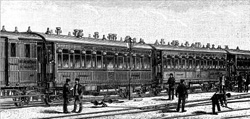 Here is another train puzzle, this time from J. A. H. Hunter’s Entertaining Mathematical Teasers:
Here is another train puzzle, this time from J. A. H. Hunter’s Entertaining Mathematical Teasers:
“Mike had made the [train] trip many times. ‘That’s the morning express from Tulla we’re passing,’ he said. ‘It left Tulla one hour after we pulled out from Brent, but we’re just 25% faster.’ ‘That’s right, and we’re also passing Cove, two-thirds the distance between Brent and Tulla,’ Martin agreed. ‘So we’re both right on schedule.’ Obviously a couple of train buffs! Assuming constant speeds and no stops, how long would it be before they reached Tulla?”
See the Train Buffs for a solution.

 This is another train puzzle by H. E. Dudeney. This one has some hairy arithmetic.
This is another train puzzle by H. E. Dudeney. This one has some hairy arithmetic. Yet another train problem from H. E. Dudeney.
Yet another train problem from H. E. Dudeney. This is another train puzzle from H. E. Dudeney, which is fairly straight-forward.
This is another train puzzle from H. E. Dudeney, which is fairly straight-forward. This is one of H. E. Dudeney’s train puzzles.
This is one of H. E. Dudeney’s train puzzles. Here is another Presh Talwalkar problem that seems unsolvable at first glance.
Here is another Presh Talwalkar problem that seems unsolvable at first glance.